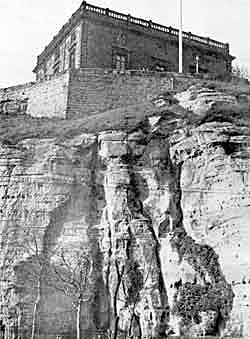< Previous | Contents | Next >
Nottingham Castle
 |
NOTTINGHAM CASTLE on its bluff 133 feet above the Boulevard, occupies a site which has been used for military purposes ever since Peveril erected his castle at the Conqueror’s orders in 1068, and it is probable that even before then there was some sort of fortress upon this commanding hill.
All through the Middle Ages Nottingham Castle was a fortress-palace of great importance, and was the frequent residence of Kings of England, reaching its fullest development during the reign of Richard III.
But this stronghold was "sleighted" and rendered ruinous at the end of the Civil Wars and after the Restoration, when the site came into the hands of the first Duke of Newcastle, its noble owner decided to clear away the old buildings and to erect for himself a ducal palace where he might reside and enjoy the amenities of Nottingham. Accordingly in 1674 he commenced building from his own designs, and although he did not live to see his house completed work was carried on after his death, and Nottingham Castle was finished in 1679 at a cost of £14,002 17s. 9d.
This Cavendish Castle is the building whose outline to-day is familiar to us, and although we may regret the loss of the romantic buildings of the older castle it is as well to remember that the present buildings have a respectable antiquity, for they are as old as St. Paul’s Cathedral in London.
The style in which the Cavendish Castle is built is that of the Early Renaissance, and it is interesting to compare it with Wollaton Hall.
At first the Dukes of Newcastle spent much time in Nottingham Castle attracting by their presence the county families to the town, but gradually they abandoned it as a place of residence, and after 1795 they do not appear to have lived there at all.
However, there were sporadic returns to the Castle, as for instance in 1776, when a grand ball was given by the Earl of Lincoln, Colonel of the Notts. Militia. A few years later the building was occupied by a Miss Kirby, who was celebrated for her hospitality, particularly her breakfasts and her oyster suppers, and it is pleasant to think that so late as 1825 Miss Creaves lived there, and that she used a Sedan chair to reach Friar-lane Chapel.
In 1831 the building was destroyed by the Reform Bill rioters, and the damage was such that the Duke was awarded £21,000 as compensation. The building was gutted, leaving little but the shell standing, and it remained desolate for many years, until at last it was acquired on a long lease by the Corporation of Nottingham, and after its interior had been remodelled it was opened as a Museum of Art on 3 July, 1878.
